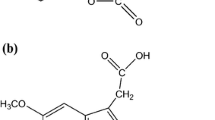Abstract
The studies showed that Decametoxin is released from thread in amounts not exceeding the standards issued by the Pharmacological Committee of the USSR Ministry of Health. The rate of release of Decametoxin from the thread decreases in time; according to the data from the extraction-photometric method, the rate of “release” of Decametoxin is constant and maximum for up to 24 h, and according to the calculation based on weight loss, the rate slows according to a logarithmic law and is maximum for up to 6 h. The concentration of Decametoxin in the region of the suture will probably be, maximum for two days. Decametoxin does not form chemical bonds with BF-6 adhesive or polycaproamide, but the polymer coating of the thread acts as a microdispenser of the antimicrobial.
Similar content being viewed by others
References
N. L. Kuz'mina, B. L. Biber, et al.,Problems of Fabrication and Use of Surgical Suture Material [in Russian], Data Sheet, NIITEKhim, Moscow (1989).
Information for Pharmaceutical and Therapeutic Institutions [in Russian], No. 6, Meditsina, Tashkent (1989), p.22.
Additional information
Institute of Problems of Material Sciences, National Academy of Sciences of Ukraine, Kiev. Translated fromKhimicheskie Volokna, No. 5, pp. 33–37, September–October, 1999.
Rights and permissions
About this article
Cite this article
Kovtun, E.A., Baglei, N.N., Plygan', E.P. et al. Study of the kinetics of release of Decametoxin from modified surgical sutures in aqueous medium. Fibre Chem 31, 374–379 (1999). https://doi.org/10.1007/BF02364369
Issue Date:
DOI: https://doi.org/10.1007/BF02364369




